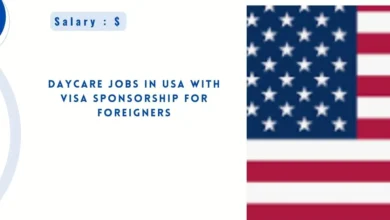Visa Sponsorship Sewing Jobs in USA 2025 – Apply Now
In its basic form, sewing is the act of joining things together with stitches that can be made by hand or by machine. In the United States, sewing jobs include a wide range of roles in the fashion, clothing, and textile industries, as well as industrial and custom stitching jobs. In the United States, the average pay for a sewing job is between $28,000 and $40,000 per year, or $14 to $20 an hour.
For skilled workers, these jobs have a lot of promise. Let’s find out everything we can about sewing work in the US.
Key Points:
- Job Title: Sewing Professional (Various Roles)
- Location: United States (Multiple locations depending on employer)
- Visa Sponsorship: Available (H-2B, EB-3, or other relevant work visas)
Requirements for Visa Sponsorship Sewing Jobs in USA:
- Educational Background: Sometimes, you need a high school diploma or a general education diploma (GED) to work as a SOC 261 employee.
- Work Experience: It might be helpful to have work experience in the fashion design, cloth, or stitching industries.
- Technical Proficiency: The candidate must know how to use sewing tools, cut materials, and work with different kinds of fabrics. It is also very important to know about measurements, trends, and changes.
- Attention to Detail: The level of delicacy and tightness of work are very important in sewing jobs, especially those that involve fashion designer clothes or clothes that are made to order.
Duties of Sewing Jobs in USA:
- Fabric Cutting and Measuring: It is very important to follow the right steps for cutting and measuring during the production process to make sure the finished product meets all the requirements.
- Reading and Following Patterns: Tailors and seamstresses need to be able to fully understand pattern directions, layouts, and any other technical drawings in order to make certain textiles or clothes.
- Making Changes to Clothes: Many sewing jobs require making changes to clothes, like hemming, trimming, or fixing clothes that are broken in some way.
- Quality Control: Part of the job is to make sure that the products are defect-free and that the seams have the right number of stitches and that there are no obvious loose threads.
Check Also: Costume Designer Jobs in Canada with Visa Sponsorship
USA Sewing Employment Opportunities with Visa:
International workers looking for stable jobs in the clothing and textile business can easily get to work in other countries by finding sewing jobs in the US that will sponsor their visas. Clothing factories, fashion houses, tailoring shops, and furniture companies are all hiring skilled sewists in the U.S. to keep up with the growing need for production and stitching work of high quality. A lot of these jobs offer ways to get a visa sponsored, like the H-2B short work visa or long-term employment visas.
Stitching and Tailoring Careers in USA for Immigrants:
There is a growing need for people with sewing and making skills in the United States, especially in fields like:
- Clothing production (factories that make clothes, uniforms, and sportswear)
- Services for fashion and shop tailoring
- Jobs that involve sewing upholstery and furniture
- Sewing jobs in the auto and industry sectors
They give foreigners the chance to get training and work experience while also giving them the chance to build long-term careers in the U.S. sewing and textile sector.
Skilled Sewing Jobs in USA for International Applicants:
Employers in the United States are actively hiring skilled sewists from other countries who know how to do machine stitching, pattern cutting, needlework, and custom tailoring. People who know how to use industrial sewing tools or how to handle fabric properly are in high demand. A lot of companies offer more than just visa sponsorship. They also offer perks like helping with housing and training programs.
Benefits of Sewing Jobs:
- Creative Expression: Lets people work with patterns, fabrics, and styles to make their creative thoughts come to life.
- Diverse Opportunities: There are a lot of different job opportunities in the fashion, upholstery, manufacturing, and custom tailoring businesses.
- High Demand: Professional sewists are always in high demand in the clothing, textile, and costume businesses.
- Accessibility for Beginners: Many sewing jobs require little or no formal schooling, which makes it easier to start a career.
- Potential for Self-Employment: You could start your own business doing specific tailoring, alterations, or design.
- Steady Income: This type of work is stable and may include overtime in the retail or manufacturing fields.
- Skill Development: Improves accuracy, attention to detail, and creative skills that can be used in many fields.
- Career Growth: The chance to move up and become a pattern maker, fashion designer, or production manager, among other jobs.
Salary:
What people get paid for sewing jobs in the US depends on things like the job description, their training, and where the job is located. On average, people who work in sewing can expect to make:
- Entry-level jobs pay between $28,000 and $40,000 a year.
- Expert Sewers: This amount is usually between $35,000 and $50,000 per year.
- For specialized jobs like pattern makers and tailors, the yearly pay is between $40,000 and $60,000.
- For supervisory jobs, the pay range is $50,000 to $75,000 per year.
Types of Jobs:
A tailor is a trained professional who makes clothes for specific customers, changes them by adding or taking away sizes, and fixes them.
- Seamstress/Seamster: Sewers, tailors, or stitchers who make and join clothes, accessories, or home textiles are called seamstresses or seamsters.
- Pattern Maker: It is the job of pattern makers to make clothing patterns that match what the artist wants. They are also involved in making and preparing clothes.
- Specialist Costume Designer: Specialty costume designers, like theatrical costume makers and tailors, plan and sew outfits for burlesque shows, movies, and other events.
- Upholsterer: Sewers make furniture, seats for transportation vehicles, and other similar things of a similar nature.
- Embroidery Machine Operator: As an embroidery machine operator, you will use an embroidery machine to add small details, emblems, or brand logos to clothes and fashion fabrics.
- Assembler of Garments: Assemblers of garments are factory workers who put together and sew together parts of clothes and other items that go with them.
- Worker in the textile industry: This includes people who weave, knit, and spin fabrics, as well as people who make clothes out of fabrics and people who check the quality of the clothes.
- Sewing Supervisor: It is the job of sewing supervisors to make sure that the production and quality goals are met by managing the sewing sub-groups.
- Industrial Sewing Machine Operator: This job involves using industrial sewing machines in a factory to sew through thick materials like leather and cloth.
Application Process:
- Job search platforms: These include social networks, websites that help you find jobs, forums, job-related message boards, company websites, and traditional career sites.
- Make a Resume and a Portfolio: Write a resume that lists your sewing experience, skills, achievements, and qualifications. If it is possible, include a collection of the best work you have done so far.
- Apply for Jobs Online: You can send your resume and cover letter directly to the company’s website, to online job search sites that are currently open, or to employment companies that focus on textile and sewing jobs.
Fraquality Asked Question:
What is the hourly rate for sewing?
15% of people make $15.62 a month. It’s unusual for wages to be below this. $75.47% of people earn that much.
How to turn sewing into a career?
Thinking about getting a job as a tailor? You can use your skills to make clothes fit better for people in your area. Helping a neighborhood artist or designer with their work, on the other hand, can be fun. You could also become the head sewist for a neighborhood theater’s costume department.
Is sewing a good career?
Finding a way to make good money by sewing is hard. You also have to work hard to be successful in the design field. But it’s important to know how to sew and tailor clothes when you’re creating them. Making changes is also a low-paying job. As a hobby, sewing is enjoyable and a creative way to spend time.




